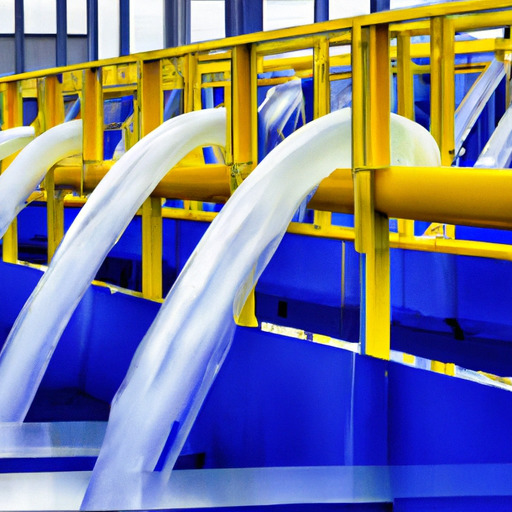In the world of wastewater treatment, there is an exciting advancement on the horizon that promises to revolutionize the way we clean our water: advanced oxidation processes (AOPs). These innovative methods utilize powerful chemical reactions to remove contaminants and pollutants from wastewater, providing a more efficient and effective solution than traditional treatment methods. With the potential to significantly improve water quality and protect the environment, AOPs are undoubtedly the future of wastewater treatment.
Overview of Wastewater Treatment
Wastewater treatment plays a crucial role in maintaining environmental health and preserving the quality of water resources. It involves the removal of contaminants and pollutants from wastewater before it is discharged into the environment. Wastewater can be generated from various sources, including domestic households, industries, and agricultural activities. The treatment of wastewater is necessary to mitigate the adverse effects it can have on the environment and public health.
Types of Wastewater
There are different types of wastewater, each with its own unique composition and characteristics. Domestic wastewater, also known as sewage, is the most common type and mainly consists of water from toilets, sinks, and showers. Industrial wastewater, on the other hand, comes from industrial processes such as manufacturing, mining, and chemical production. Agricultural wastewater is generated from farming activities, including irrigation and the use of fertilizers and pesticides.
Importance of Wastewater Treatment
Effective wastewater treatment is vital for several reasons. Firstly, untreated wastewater can contain harmful pollutants, such as heavy metals, pathogens, and organic compounds, that have the potential to harm human health and the environment. Secondly, untreated wastewater can contaminate surface water and groundwater sources, making them unsuitable for drinking, agriculture, and recreational purposes. Thirdly, wastewater treatment helps in the conservation and reuse of water, which is particularly valuable in regions facing water scarcity.
Challenges in Traditional Wastewater Treatment
Traditional wastewater treatment methods, such as biological treatment and chemical precipitation, have limitations when it comes to effectively removing certain contaminants from wastewater. These methods may be inefficient in treating emerging pollutants, which are newly identified contaminants that were not previously regulated or considered in treatment processes. Emerging pollutants, including pharmaceuticals, personal care products, and microplastics, pose environmental risks and require advanced treatment technologies.
Emerging Pollutants
The presence of emerging pollutants in wastewater adds complexity to the treatment process. Conventional treatment methods often struggle to effectively remove these pollutants, as they may be present in trace amounts and have unique chemical structures. Consequently, these pollutants can persist in the environment and have the potential to accumulate in organisms, leading to long-term ecological consequences. Therefore, alternative treatment approaches that can target and eliminate these emerging pollutants are necessary.
Introduction to Advanced Oxidation Processes (AOPs)
Advanced Oxidation Processes (AOPs) are innovative treatment methods that offer a promising solution to the challenges faced by traditional wastewater treatment methods. AOPs are based on the production of highly reactive hydroxyl radicals, which can rapidly degrade a wide range of pollutants present in wastewater. These radicals are generated through various mechanisms, including the activation of oxygen molecules by energy sources such as UV light, ozone, or ultrasound.
Definition and Principles of AOPs
AOPs are characterized by their ability to generate hydroxyl radicals, which have a high oxidation potential. The hydroxyl radicals react with the contaminants present in the wastewater, leading to their degradation into simpler and less harmful compounds. AOPs operate through a combination of physical, chemical, and biological processes, making them effective in removing a diverse range of pollutants. The principles of AOPs involve the production of hydroxyl radicals and the subsequent reactions that lead to the degradation of pollutants.
Advantages of AOPs over Traditional Methods
AOPs offer several advantages over traditional wastewater treatment methods. Firstly, AOPs can effectively degrade emerging pollutants that are challenging to remove with conventional treatment methods. Secondly, AOPs can operate under mild conditions, minimizing the production of secondary pollutants and reducing the need for additional chemicals. Thirdly, AOPs have a high degree of flexibility and can be tailored to treat different types of wastewater, making them suitable for a wide range of applications.
Different Types of AOPs
There are several types of AOPs that have demonstrated effectiveness in wastewater treatment. These include photocatalysis, ozonation, the Fenton process, sonolysis, and homogeneous reactions. Each of these AOPs utilizes different mechanisms to generate hydroxyl radicals and achieve the degradation of pollutants in wastewater.
Photocatalysis
Photocatalysis involves the use of a semiconductor material, usually titanium dioxide (TiO2), which is activated by UV light. When the catalyst is exposed to UV light, it creates electron-hole pairs that can react with water and oxygen molecules, leading to the formation of hydroxyl radicals. These radicals then initiate the degradation of pollutants present in the wastewater.
Ozonation
Ozonation is a process where ozone (O3) is introduced into the wastewater. Ozone is a powerful oxidant that can directly react with organic contaminants, leading to their degradation. Additionally, ozonation also generates hydroxyl radicals through reactions between ozone and water molecules. This combination of direct oxidation and hydroxyl radical generation makes ozonation an effective AOP for wastewater treatment.
Fenton Process
The Fenton process involves the addition of ferrous ions (Fe2+) and hydrogen peroxide (H2O2) to the wastewater. This combination generates hydroxyl radicals through a reaction between the ferrous ions and hydrogen peroxide. The hydroxyl radicals then initiate the degradation of pollutants, leading to the removal of contaminants from the wastewater.
Sonolysis
Sonolysis utilizes high-intensity ultrasound waves to create cavitation bubbles in the wastewater. The collapse of these bubbles generates shock waves and localized high temperatures, which produce hydroxyl radicals. The hydroxyl radicals can then react with the contaminants, breaking them down into simpler compounds.
Homogeneous Reactions
Homogeneous reactions involve the direct addition of a chemical oxidant, such as hydrogen peroxide or persulfate, to the wastewater. These chemical oxidants react with the contaminants, leading to the generation of hydroxyl radicals. Homogeneous reactions are relatively simple and cost-effective AOPs that can be easily implemented for wastewater treatment.
Mechanisms and Reactions in AOPs
The key mechanism in AOPs is the formation of hydroxyl radicals, which are extremely reactive species capable of oxidizing a wide range of pollutants. Hydroxyl radicals can degrade organic pollutants through various degradation pathways, including direct oxidation, electron abstraction, and radical addition reactions. The synergistic effects of multiple AOPs can enhance the degradation efficiency by providing different pathways for pollutant degradation.
Formation of Hydroxyl Radicals
Hydroxyl radicals are formed in AOPs through different mechanisms. In photocatalysis, UV light activates the semiconductor catalyst to create electron-hole pairs. The holes can react with water, producing hydroxyl radicals. In ozonation, ozone reacts with water molecules in the presence of catalysts, releasing hydroxyl radicals. In the Fenton process, the reaction between ferrous ions and hydrogen peroxide generates hydroxyl radicals. Sonolysis creates hydroxyl radicals through shock waves generated by the collapse of cavitation bubbles. Homogeneous reactions involve the direct addition of chemical oxidants that generate hydroxyl radicals.
Degradation Pathways of Pollutants
The degradation pathways of pollutants in AOPs depend on their chemical structure and reactivity. Hydroxyl radicals can react with pollutants through direct oxidation, which involves the transfer of an electron from the pollutant to the hydroxyl radical. This oxidation leads to the fragmentation and mineralization of the pollutant. Electron abstraction reactions involve the removal of an electron from the pollutant molecule by the hydroxyl radical. This reaction forms a radical intermediate that can further react with hydroxyl radicals or other reactive species. Radical addition reactions involve the addition of a hydroxyl radical to the pollutant molecule, leading to its transformation into a less harmful compound.
Synergistic Effects of Multiple AOPs
The combination of different AOPs can result in synergistic effects, enhancing the degradation efficiency of pollutants. By utilizing multiple AOPs, different degradation pathways can be activated simultaneously, leading to a more effective removal of pollutants from wastewater. This combination of AOPs can also ensure the complete mineralization of pollutants into harmless byproducts, further improving the quality of the treated wastewater.
Efficiency and Operational Considerations
Several factors influence the efficiency of AOPs in wastewater treatment. These include the initial concentration and types of pollutants in the wastewater, the specific AOP employed, and the reaction conditions such as temperature, pH, and contact time. Optimization of these reaction conditions is crucial to ensure the maximum degradation efficiency of pollutants. Additionally, energy requirements and costs should be taken into consideration when implementing AOPs, as some processes may require significant energy inputs.
Optimization of Reaction Conditions
To maximize the efficiency of AOPs, it is important to optimize the reaction conditions. The initial concentration of pollutants should be carefully determined to ensure that the AOP operates within its optimal range. The pH of the wastewater can also affect the degradation efficiency, as it influences the availability of hydroxyl radicals and the reaction rates. Temperature control is another important aspect, as higher temperatures can enhance the reaction rates but may also increase energy consumption.
Energy Requirements and Costs
The energy requirements of AOPs can vary depending on the specific process and the scale of the treatment plant. Processes such as photocatalysis and ozonation typically require energy inputs for UV light generation or ozone production. The operational costs of AOPs can also include the cost of chemicals, catalysts, and maintenance. However, the potential for reusing and recycling treated wastewater can provide economic benefits and contribute to the overall sustainability of the wastewater treatment system.
Applications of AOPs in Wastewater Treatment
AOPs have a wide range of applications in wastewater treatment, offering effective solutions for various types of contaminants. AOPs can be utilized to remove organic contaminants such as pharmaceuticals, personal care products, and pesticides from the wastewater. The generation of hydroxyl radicals in AOPs also allows for the disinfection and deactivation of pathogens, ensuring the safety of the treated wastewater. Additionally, AOPs can be employed in the treatment of industrial wastewaters, which may contain complex and challenging pollutants.
Removing Organic Contaminants
AOPs have shown great potential in removing organic contaminants from wastewater. These contaminants, including pharmaceuticals and personal care products, can be resistant to conventional treatment methods. The generation of hydroxyl radicals in AOPs allows for the oxidation and mineralization of these organic compounds, effectively removing them from the wastewater and minimizing their environmental impact.
Disinfection and Deactivation of Pathogens
AOPs can provide an effective means of disinfecting wastewater and deactivating pathogens. The high reactivity of hydroxyl radicals allows for the inactivation of bacteria, viruses, and other microorganisms present in the wastewater. By effectively eliminating these pathogens, AOPs contribute to the prevention of waterborne diseases and ensure the safety of the treated wastewater for various applications.
Treatment of Industrial Wastewaters
Industrial wastewaters can be complex and contain a wide range of pollutants that are challenging to remove. AOPs offer a viable solution for the treatment of industrial wastewaters, as they can target and degrade diverse pollutants. The flexibility of AOPs allows for customization to suit the specific contaminants present in industrial wastewaters, ensuring efficient and cost-effective treatment.
Case Studies and Success Stories
Several real-world scenarios have demonstrated the successful implementation of AOPs in wastewater treatment. One notable case is the use of photocatalysis in the treatment of pharmaceutical wastewater, where the removal of complex organic compounds was achieved with high efficiency. Another success story involves the application of ozonation in the treatment of dyeing industry wastewater, leading to significant color removal and improved water quality. These case studies highlight the effectiveness and versatility of AOPs in addressing specific wastewater treatment challenges.
Notable Achievements in Wastewater Treatment
AOPs have achieved remarkable advancements in the field of wastewater treatment. These advancements include the successful removal of emerging pollutants, such as microplastics and pharmaceuticals, which were previously difficult to treat using conventional methods. AOPs have also demonstrated their potential in achieving complete mineralization of pollutants, ensuring the production of high-quality treated wastewater. These achievements showcase the effectiveness and promise of AOPs as a sustainable solution for wastewater treatment.
Environmental and Regulatory Considerations
While AOPs offer numerous benefits in wastewater treatment, it is essential to consider their potential environmental and regulatory implications. The formation of byproducts during AOPs can generate additional toxic compounds, which may require further treatment or monitoring. Compliance with regulatory standards is crucial to ensure that the treated wastewater meets the necessary quality requirements for discharge or reuse. Additionally, a life cycle assessment of AOPs should be conducted to evaluate their overall environmental impact and sustainability.
Toxicity and Byproduct Formation
The generation of byproducts during AOPs can have potential toxicity concerns. These byproducts may exhibit varying degrees of toxicity, depending on their chemical nature and concentration. It is essential to identify and monitor these byproducts to assess their potential impact on human health and the environment. Proper characterization and treatment of the byproducts are necessary to ensure the overall safety and sustainability of the wastewater treatment process.
Compliance with Regulatory Standards
Wastewater treatment facilities must comply with regulatory standards for discharging treated wastewater into the environment or reusing it. Regulatory agencies establish limits for various parameters, including contaminants, chemical oxygen demand (COD), and bacterial counts. AOPs should be capable of meeting these regulatory standards to ensure the protection of public health and the environment. Monitoring and regular testing of the treated wastewater are essential to demonstrate compliance with regulatory requirements.
Life Cycle Assessment of AOPs
A life cycle assessment (LCA) of AOPs should be conducted to evaluate their overall environmental impact. LCA considers the environmental aspects and potential impacts associated with the entire life cycle of AOPs, from raw material extraction to system operation and disposal. The assessment provides insights into energy consumption, resource utilization, and potential emissions, allowing for the identification of areas for improvement and the promotion of sustainable practices in wastewater treatment.
Future Outlook: AOPs in Wastewater Treatment
The future of wastewater treatment lies in the widespread adoption of advanced oxidation processes (AOPs). AOPs offer a versatile and effective solution to the challenges faced by traditional treatment methods, particularly in treating emerging pollutants. The ongoing research and development in AOPs hold great promise for further advancements in the field of wastewater treatment. Additionally, the synergistic use of AOPs with other treatment methods, such as biological treatment and membrane processes, can enhance the overall efficiency and sustainability of wastewater treatment systems.
Potential for Widespread Adoption
The potential for widespread adoption of AOPs in wastewater treatment is evident due to their versatility and effectiveness. As emerging pollutants become more prevalent and conventional treatment methods struggle to address them, AOPs offer a viable solution. The ability of AOPs to target a wide range of pollutants and provide high-quality treated wastewater makes them an attractive option for water resource management. Continued advancements in AOP technologies and their integration into existing treatment infrastructure will further facilitate their widespread adoption.
Synergies with Other Treatment Methods
AOPs can complement and enhance the performance of other treatment methods. For example, combining AOPs with biological treatment can provide a more comprehensive approach to wastewater treatment. AOPs can act as a pre-treatment step to degrade complex organic pollutants, followed by biological treatment to remove the remaining organic matter. The integration of AOPs with membrane processes can also improve the removal of trace contaminants and improve the overall efficiency of the treatment system. The synergies achieved through the combination of different treatment methods contribute to the development of more sustainable and efficient wastewater treatment systems.
In conclusion, advanced oxidation processes (AOPs) offer a promising future for wastewater treatment. With their ability to generate highly reactive hydroxyl radicals, AOPs can effectively degrade a wide range of pollutants, including emerging contaminants resistant to traditional methods. The various types of AOPs, such as photocatalysis, ozonation, the Fenton process, sonolysis, and homogeneous reactions, provide flexible and customizable options for treating different types of wastewater. The mechanisms and reactions in AOPs, along with the synergistic effects of multiple AOPs, contribute to the efficient removal of pollutants and the production of high-quality treated wastewater. While challenges such as optimization of reaction conditions, energy requirements, and environmental considerations exist, the future outlook for AOPs in wastewater treatment is promising. The potential for widespread adoption and synergies with other treatment methods highlight the importance of advancing and implementing AOPs to ensure the sustainability of wastewater treatment systems and the protection of public health and the environment.



